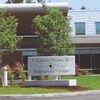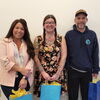Former Harriman head opens new architecture firm
 Photo/Rebecca Goldfine
Patrick Costin recently founded Canal 5 Studio, an architecture firm in Portland
Photo/Rebecca Goldfine
Patrick Costin recently founded Canal 5 Studio, an architecture firm in Portland
This winter, architect Patrick Costin left his prestigious position as board chair of Harriman Architects + Engineers, a 141-year-old firm with offices in Portland and Auburn, to start a much smaller company and focus on what he says are his two professional passions: technology and design. "Being the head of a large, multidisciplinary firm that has a diverse client base made it challenging to find the time to really focus on the areas of practice that interest me: design excellence and technology," says Costin.
Although it is just about six weeks old, Costin's new five-person firm, Canal 5 Studio, has already embarked on a few projects in its neighborhood, including a redesign of the desolate, shadowed courtyard below its eighth-floor office in One Canal Plaza on Middle Street. The building's owner, Tim Soley, has asked Canal 5 to create a more inviting urban area that includes a new restaurant.
To show off the project's preliminary renderings, Costin, 52, opened a 3-D design program on his office computer, navigating through it as if in a video game. He first displayed a wide view of the glassed-in restaurant, and then moved down the side of the building to point out the unusual walls before swiveling around to look at the courtyard's outdoor seating.
These 3-D models, known in architecture circles as BIM for building information modeling, will be fundamental to Canal 5's operations. Costin says BIM is radically transforming his industry, and that he wants to get closer to the "leading edge of that change."
"It's difficult to be part of a large, diverse organization and change quickly," he says. Harriman has roughly 75 employees. "I want to be in a position where I can embrace change as quickly as possible. It's simpler to do that if you're a small ship with everyone aligned."
When he left Harriman in February, three years after becoming board chair and roughly 16 years with the firm, Costin says four colleagues asked to join him: Timothy Hart, Jessica Johnson, James Gauthier and Lodrys Gomez. Costin says this team worked on projects together at Harriman, including Maine Heart Surgical Associates on Congress Street and MaineHealth's new headquarters on Free Street.
Harriman President and CEO Clifton Greim says he supports Costin's desire to run his own firm, where he says Costin will have the "flexibility and maneuverability" to make a difference in the design world. "He saw this opportunity, and he saw the grains of sand go by in the hourglass, and said, ‘If I want to do this, I have to do it now,'" Greim says. He adds that while Harriman has also embraced BIM for many of its projects, the equipment is a substantial investment, and the company plans to update all its architects' work stations over the next two years.
Another Portland architect, Walter Arsenault, with Design Group Collaborative, says he was a bit surprised to hear of Costin's move, adding that it's not common for architects to jump ship to start a new venture. "The larger firms offer stability, a regular pay check, health insurance, etc. It takes a lot of courage to start your own firm," he writes in an e-mail. He adds that he's known Costin for many years, and that he expects he'll do well.
Arsenault says, too, that while his firm incorporates BIM into some projects, he believes that not all of them, especially the smaller ones, require it.
While many architecture firms use BIM to some degree these days, Costin says he'll differentiate his company by having it play a prominent role in all his projects. To use BIM effectively, Costin says the project's client, architect, engineer and contractor all must be involved from the beginning of a project, as opposed to pulling in the contractor after designs have been drawn.
This is necessary because BIM is more complex than using a two-dimensional drawing, Costin explains. "The information that is developed during the documentation and design of a project is more robust and requires more rigor in resolving what the design will actually require," he says. "Because you're frontloading a lot of the decisions, the early input of the design team and contractor is even more important."
Costin says approaching projects collaboratively and using high-tech software can also cut down on ballooning budgets. With BIM, it's less likely a builder will run into a problem halfway through a project, such as discovering faulty duct layouts. All these details, and their costs, will already have been incorporated into the model. "This is opposed to spending a lot of time designing and then having to check on cost," he says. "Often what you have designed and what you have budgeted is not in alignment."
Canal 5 is looking to work with like-minded contractors and engineers, Costin says. But at the moment, only a small number of contractors are regularly using BIM, and the recession has slowed down the rate of adoption. The cost to buy the software and a computer to run it is about $10,000, Costin says.
Besides working on the courtyard project, Canal 5 has begun renovating and expanding an InterMed building in Yarmouth and designing an additional story on One Canal Plaza, along with a few other projects.
Though business is decent, Costin says he has no desire to grow the company by more than a few employees. "The goal of the firm is not to grow for growth's sake," he says. "We don't want to be a production house."
Part of his desire to stay compact has to do with weathering the ups and downs of the economy. "Ours is a cyclical industry," he says. "We don't want to go up and down, up and down. That's destructive."
During the last recession, roughly 30% of jobs in the architecture field were lost in Maine, according to Scott Brown, president of the board for Maine's chapter of the American Institute of Architects. Harriman, in the early part of the recession, let go 18% of its firm and instituted temporary pay cuts, Costin says.
All of Canal 5's five employees are equity partners in the LLC, and the goal is to distribute yearly earnings between $100,000 and $200,000, Costin says. "And that will vary depending on the year and economy," he adds.
At the moment, the economy looks as if it will swing back up, and Costin hopes it will bring his firm with it. "It's always challenging to start a new business and enter a field with many good firms," he says. "It's a competitive environment. But we believe we have a body of work that speaks for itself."










Comments